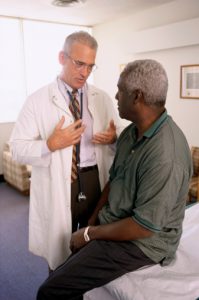It is no secret that men are less vigilant about receiving healthcare than women. In fact a report from the Centers for Disease Control and Prevention (CDC) indicates that men in the United States are 80% less likely than women to visit their doctor’s office regularly and schedule routine medical screenings.
There are several reasons given as to why men steer clear of the doctor’s office and delay treatment-some are, “there is probably nothing wrong” or “I’d rather tough it out.” This laid-back approach to health care can unfortunately result in shorter or less healthy lives for men, if medical conditions go untreated. The good news is that many of the leading threats to men’s health are preventable and treatable if detected early. Here are few chronic health conditions that affect men the most:
- Cardiovascular disease also known as heart disease is one of the leading health risks facing men today. According to the American Heart Association (AHA), more than one in three adult men has heart disease. Although it may seem that something so serious should have warning signs, one may be developing heart disease without knowing it. Luckily, there are many lifestyle changes that can be made to ward off heart disease, such as not smoking, following a heart-smart diet, and being physically active.
- Lung cancer is one of the few cancers that can often be prevented simply by not smoking. Men who are at high risk for developing lung cancer may want to talk to a health care provider about quitting smoking- if they are smokers and getting yearly low-dose CT scans to test for early lung cancer.
- Prostate cancer is typically found in men over the age of 65. The chance of getting prostate cancer increases as a man gets older. For reasons that are still unknown, African American men are more likely to develop prostate cancer than other races. Men with a family history of prostate cancer are at a high risk for developing the disease.
- Type 2 Diabetes is the most common type of diabetes found in men. It affects approximately 95% of the 13 million men with the disease in the United States. Type 2 diabetes affects the body’s ability to use insulin properly. This can elevate sugar levels and cause damage to the body over time.
The first step to staying healthy is educating yourself, and then taking the necessary precautions to reduce your risk. It is equally as important to develop a relationship with your healthcare provider. Your doctor can create a health care plan to screen, diagnose and treat diseases that you may at be risk for developing.
To schedule an appointment with a primary care physician, please call the Ambulatory Care Center at Flushing Hospital at 718-670-5486.
For more hospital events, highlights, health and fitness tips, visit us on
Facebook.com/Flushing Hospital and follow us on Twitter @FHMC_NYC !
All content of this newsletter is intended for general information purposes only and is not intended or implied to be a substitute for professional medical advice, diagnosis or treatment. Please consult a medical professional before adopting any of the suggestions on this page. You must never disregard professional medical advice or delay seeking medical treatment based upon any content of this newsletter. PROMPTLY CONSULT YOUR PHYSICIAN OR CALL 911 IF YOU BELIEVE YOU HAVE A MEDICAL EMERGENCY.










